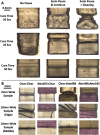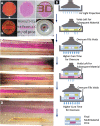3D Printing of Multimaterial Contact Lenses
- PMID: 37364228
- PMCID: PMC10336843
- DOI: 10.1021/acsbiomaterials.3c00175
3D Printing of Multimaterial Contact Lenses
Abstract
3D printing of multimaterial objects is an emerging field with promising applications. The layer-by-layer material addition technique used in 3D printing enables incorporation of distinct functionalized materials into the specialized devices. However, very few studies have been performed on the usage of multimaterial 3D printing for printable photonic and wearable devices. Here, we employ vat photopolymerization-based 3D printing to produce multimaterial contact lenses, offering enhanced multiband optical filtration, which can be valuable for tackling ocular conditions such as color blindness. A combination of hydroxyethyl methacrylate (HEMA) and polyethylene glycol diacrylate (PEGDA) was used as the base hydrogel for 3D printing. Atto565 and Atto488 dyes were added to the hydrogel for wavelength filtering, each dye suitable for a different type of color blindness. Multimaterial disks and contact lenses, with separate sections containing distinct dyes, were 3D-printed, and their optical properties were studied. The characteristics of multimaterial printing were analyzed, focusing on the formation of a uniform multimaterial interface. In addition, a novel technique was developed for printing multiple dyed materials in complex lateral geometrical patterns, by employing suitable variations in CAD models and the UV curing time. It was observed that the multimaterial printing process does not negatively affect the optical properties of the contact lenses. The printed multimaterial contact lenses offered a combined multi-band color blindness correction due to the two dyes used. The resulting optical spectrum was a close match to the commercially available color blindness correction glasses.
Keywords: contact lenses; hydrogel; multimaterial 3D printing; vat photopolymerization; wavelength filtering.
Conflict of interest statement
The authors declare no competing financial interest.
Figures








References
-
- Liu Z.; Meyers M. A.; Zhang Z.; Ritchie R. O. Functional gradients and heterogeneities in biological materials: Design principles, functions, and bioinspired applications. Prog. Mater. Sci. 2017, 88, 467–498. 10.1016/j.pmatsci.2017.04.013. - DOI
-
- Missinne J.; Misseeuw L.; Liu X.; Salter P. S.; van Steenberge G.; Adesanya K.; van Vlierberghe S.; Booth M. J.; Dubruel P. Planar polymer waveguides with a graded-index profile resulting from intermixing of methacrylates in closed microchannels. Opt. Mater. 2018, 76, 210–215. 10.1016/j.optmat.2017.12.039. - DOI
-
- Salmoria G. V.; Klauss P.; Zepon K.; Kanis L. A.; Roesler C. R. M.; Vieira L. F. Development of functionally-graded reservoir of PCL/PG by selective laser sintering for drug delivery devices. Virtual Phys Prototyp. 2012, 7, 107–115. 10.1080/17452759.2012.687911. - DOI
Publication types
MeSH terms
Substances
LinkOut - more resources
Full Text Sources
Other Literature Sources
Medical
Miscellaneous

